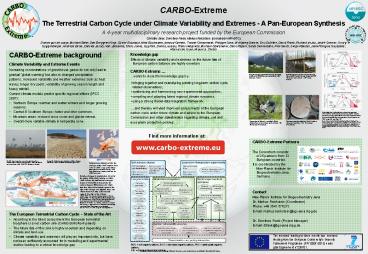CARBOExtreme PowerPoint PPT Presentation
1 / 1
Title: CARBOExtreme
1
CARBO-Extreme The Terrestrial Carbon Cycle under
Climate Variability and Extremes - A Pan-European
Synthesis A 4-year multidisciplinary research
project funded by the European Commission Christia
n Beer, Dorothea Frank, Markus Reichstein
(coordinator MPI-BGC) Dominique Arrouays, Michael
Bahn, Dan Berggren Kleja, Olivier Bouriaud, Nina
Buchmann, Arnaud Carrara, Torben Christensen,
Philippe Ciais, Wolfgang Cramer, Eric Dufrêne,
David Frank, Richard deJeu, André Granier, Georg
Guggenberger, Andreas Ibrom, Daniela Jacob, Ivan
Janssens, Chris Jones, Guy Kirk, Denis Loustau,
Franco Miglietta, Michael Obersteiner, Dario
Papale, Sonia Seneviratne, Pete Smith, Serge
Rambal, Jean-François Soussana, Marcel van Oijen,
Miguel A. Zavala
- CARBO-Extreme background
- Climate Variability and Extreme Events
- Increasing concentrations of greenhouse gases do
not only lead to - gradual global warming but also to changed
precipitation - patterns, increased variability and weather
extremes such as heat - waves, longer dry spells, variability of growing
season length and - heavy rainfall.
- Current climate models predict specific regional
effects (IPCC - 2007)
- Northern Europe warmer and wetter winters and
longer growing seasons, - Central Southern Europe hotter and drier
summers, - Mountain areas reduced snow cover and glacier
retreat, - Overall more variable climate in temperate zone.
- Knowledge gap
- Effects of climate variability and extremes on
the future fate of European carbon balance are
highly uncertain - CARBO-Extreme
- wants to close this knowledge gap by
- bringing together and reanalyzing existing
long-term carbon cycle related observations, - synthesizing and harmonizing new experimental
approaches, - compiling and adapting latest regional climate
scenarios, - using a strong model-data integration framework,
- and thereby will yield improved assessments of
the European - carbon cycle under future climate and advice to
the European - Commission and other stakeholders regarding
climate, soil and - ecosystem protection policies.
Drought experiment at CARBO-Extreme site Stubai,
Austria, June 2009 (Photo by Michael Bahn, UIBK
Innsbruck, Austria)
Rainfall exclusion experiment at state forest of
Hesse (North-Eastern France), September 2007
(Photo by Marion Zapater , INRA-Nancy, France)
Schematic showing the effect on extreme
temperatures when (a) the mean temperature
increases, (b) the variance increases, and (c)
when both the mean and variance increase for a
normal distribution of temperature. From Folland
et al. 2001, page 155, their Fig. 2.32 (Folland,
C.K., T.R. Karl, J.R. Christy, R.A. Clarke, G.V.
Gruza, J. Jouzel, M.E. Mann, J. Oerlemans, M.J.
Salinger and S.-W. Wang, 2001 Observed Climate
Variability and Change. In Climate Change 2001
The Scientific Basis. Contribution of Working
Group I to the Third Assessment Report of the
Intergovernmental Panel on Climate Change
Houghton, J.T.,Y. Ding, D.J. Griggs, M. Noguer,
P.J. van der Linden, X. Dai, K. Maskell, and C.A.
Johnson (eds.). Cambridge University Press,
Cambridge, United Kingdom and New York, NY, USA,
881pp.)
Researchers at fieldwork - sampling in Abisko
National Park, Sweden (Photo by Flurin Babst,
WSL Birmensdorf, Switzlerland)
Pinus sylvestris disc collected in Finnish
Lapland (Photo by Flurin Babst, WSL
Birmensdorf, Switzlerland)
Find more information at
CARBO-Extreme Partners The Consortium consists
of 25 partners from 12 European countries. It
is coordinated by the Max-Planck Institute
forBiogeochemistry Jena, Germany.
Drought in Mediterranean soil, island of Milos,
Greece. (Photo by Marcel van Oijen, CEH-Edinburgh
(U.K.))
KLAUS storm impact on a maritime pine forest in a
experimental watershed near Bordeaux 28.01.09
(Photo by Marie Guillot, INRA, EPHYSE Bordeaux,
France)
Temperature difference from the average during
the European heat wave of 2003 (Image by Reto
Stöckli, Robert Simmon and David Herring, NASA
Earth Observatory, based on data from the MODIS
land team.)
Relative changes in precipitation (in ) for the
period 20902099, relative to 19801999. Values
are multi-model averages based on the SRES A1B
scenario for June to August. White areas are
where less than 66 of the models agree in the
sign of the change and stippled areas are where
more than 90 of the models agree in the sign of
the change. (IPCC, 2007 Summary for
Policymakers. In Climate Change 2007 The
Physical Science Basis. Contribution of Working
Group I to the Fourth Assessment Report of the
Intergovernmental Panel on Climate Change
Solomon, S., D. Qin, M. Manning, Z. Chen, M.
Marquis, K.B. Averyt, M.Tignor and H.L. Miller
(eds.). Cambridge University Press, Cambridge,
United Kingdom and New York, NY, USA. page 16,
their Fig.SPM.7 )
Contact Max-Planck Institute for Biogeochemistry
Jena Dr. Markus Reichstein (Coordinator) Phone
49 3641 576273 E-mail markus.reichstein_at_bgc-jena
.mpg.de Dr. Dorothea Frank (Project
Manager) E-mail dfrank_at_bgc-jena.mpg.de
- The European Terrestrial Carbon Cycle State of
the Art - According to the latest assessment the European
terrestrial biosphere is a net carbon sink
(CARBOEUROPE-IP project) - The future fate of this sink is highly uncertain
and depending on climate and land-use. - Climate variability and extremes will play an
important role, but have not been sufficiently
accounted for in modelling and experimental
studies leading to a critical knowledge gap.
The research leading to these results has
received funding from the European Communitys
Seventh Framework Programme (FP7/2007-2013)
under grant agreement n226701.
SOC soil organic carbon, DOC dissolved
organic carbon, POC particulate organic carbon,
DIC dissolved inorganic carbon
Background picture adapted from Ssolbergj,
Wikimedia Commons, under Creative Commons
Attribution ShareAlike 3.0 License

